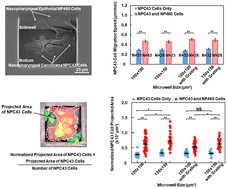Enhanced motility and interaction of nasopharyngeal carcinoma with epithelial cells in confined microwells†
Abstract
The three-dimensional (3D) structure of the extracellular matrix and cell–cell contacts are two important cues to altering cell migration behavior and the tumor formation process. In this work, we designed and fabricated microwell arrays with a grating-patterned bottom in polydimethylsiloxane platforms to systematically study the effects of confinement, changes in topography, and cell–cell contacts on the migration behavior of nasopharyngeal carcinoma (NPC43) and immortalized nasopharyngeal epithelial (NP460) cells by time-lapse imaging. When two types of cells were co-cultured in microwells, the migration speed and spreading area of NPC43 cells were significantly increased, which might be attributed to the heterotypic cell–cell contacts with NP460 cells. On a flat surface, NPC43 cells could not form clusters due to the frequent interruptions by the active movements of NP460 cells. However, in 3D microwell arrays, clusters of NPC43 cells formed on the bottom surface while the majority of NP460 cells migrated onto the sidewalls. These cell clusters could be further processed to form spheroids for drug screening. These results also revealed that the 3D microenvironments and cell–cell contacts could have significant implications for NPC cell migration and initiation of tumor formation, which will provide insight for NPC progression and dissemination.



 Please wait while we load your content...
Please wait while we load your content...